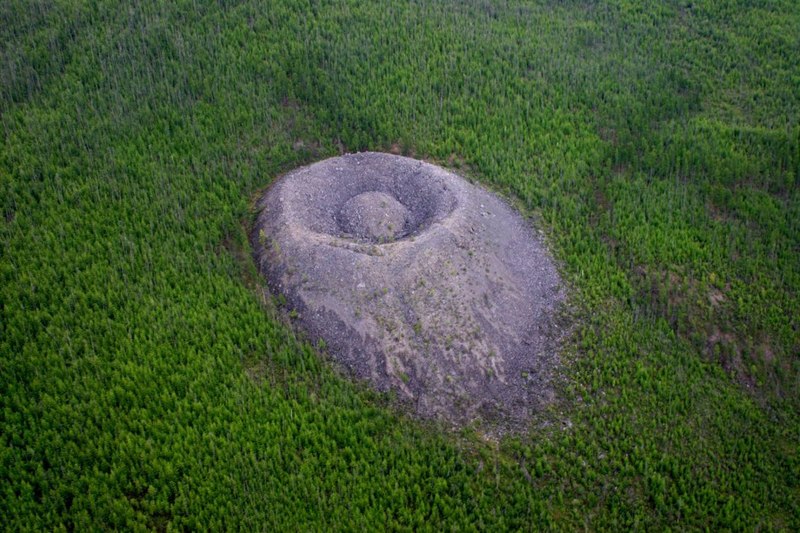A crater at least 50 meters deep and 20 meters wide has been spotted in the tundra region in Siberia. Scientists are not sure how the hole- at least the ninth spotted in the region since 2013, and so far one of the largest- formed, however they believe it is linked to a buildup of methane that exploded, a frightening result of warming temperatures in the region.
—
The crater was discovered accidentally by a Russian film crew earlier this year as they were flying over the Yamal peninsula in Siberia on an unrelated assignment.
Evgeny Chuvilin, lead research scientist at the Skolkovo Institute of Science and Technology’s Center for Hydrocarbon Recovery, who visited the site of the newest crater to study it, says, “Right now, there is no single accepted theory on how these complex phenomena are formed. It is possible they have been forming for years, but it is hard to estimate the numbers. Since craters usually appear in uninhabited and largely pristine areas of the Arctic, there is often no one to see and report them. Even now, craters are mostly found by accident during routine, non-scientific helicopter flights or by reindeer herders and hunters.”
You might also like: Alarm as Siberia Experiences Heatwave, With Temperatures 10℃ Above Average

How Do These Craters Form?
Permafrost, making up two-thirds of Siberia, is a huge natural reservoir of methane. Recent hot summers in the region, including in 2020, may have contributed to the creation of these craters.
Methane- and other gases- can accumulate in the upper layers of this permafrost, which can create pressure that is strong enough to burst through the upper layers of frozen ground, scattering earth and rocks and creating craters, in a process called “cryovolcanism.” These craters turn into lakes within two years of being formed.
Researchers studied the newest crater and older ones, and found that mounds in the Earth formed just before the explosions. The craters were also all located on gentle slopes and had a lower portion that was cylindrical before opening into a funnel, with the opening around 20 to 25 meters wide.
They believe that extremely hot summers in the region in 2012 and 2016, and again in 2020, may have contributed to the growth and blowout of these mounds, which appear and explode within as little as three to five years.
Methane accumulates in a process called “cryopeg”- a layer of unfrozen ground that never freezes because of its salt content below a table of ground ice- and acts as a trap. The gas escapes, forming a mound. When warm summers occur, the mound blows, creating the craters. Scientists say that as temperatures rise around the world and the climate continues to warm, melting permafrost is becoming more common and is therefore leading to more crater formations.
None of these features have been discovered or reported in the Alaskan or Canadian arctic. Researchers believe that the crater formations are unique to the Arctic region in Siberia because few other areas share the features believed to be necessary for them to form- a combination of table-like ground ice close to the surface, continuous permafrost with methane and unfrozen ground with saline deposits below the ice.
How Are They Linked to the Climate Crisis?
This year, Siberia experienced a prolonged heatwave, with unusually high temperatures linked to wildfires and a huge oil spill. Climate scientists called it “alarming” and believed that it would push the planet towards its hottest year on record. Towns in the area recorded extraordinarily high temperatures, with Nizhnyaya Pesha hitting 30℃ on June 9 and Khatanga, which usually has temperatures of around 0℃ that time of year, hitting 25℃ on May 22. The highest temperature recorded previously was 12℃.
If linked to the climate crisis, these conditions would have certainly contributed to the blowout of the mounds.
Some experts, however, aren’t convinced that the progressing climate crisis is causing these craters. Anecdotal evidence suggests that explosions creating craters in the tundra have been happening for generations. They instead suggest the cause of the craters to be gas trying to move to the surface from deep layers of the Earth. Others believe that the climate crisis plays a role, but that more data is needed to say definitively.
Chuvilin has promised that his team will publish more detailed information on this phenomenon in an upcoming scientific journal.
Professor Vasily Bogoyavlensky, Doctor of Engineering Sciences from the Russian Academy of Sciences, says that there are more than 7 100 heave mounds on the Yamal and Gydan peninsula and that 5-6% of these are “really dangerous.” He adds that researchers are currently working to understand which heave mounds will explode and which will not. They are also considering ways of neutralising those with the potential to explode.
Featured image by: Dmitry Semenov

















